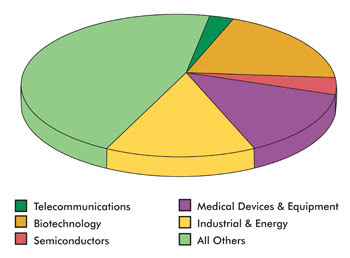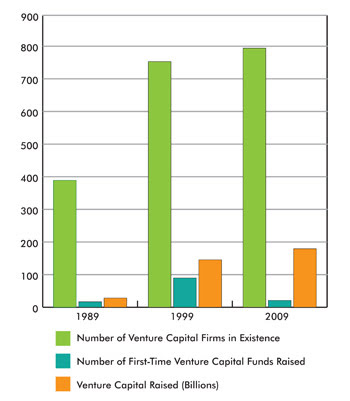Bridging the Gap Between Idea and Commercial Success
After years of sweat, toil and heavy thinking, you and your colleagues have done it –
created the Next Big Thing. Now all you have to do is start a company and hold the
door open for the line of customers who will march through. With any real luck,
you can walk away from the tenure track and the grind of academe!
Not so fast, friend. How are you going to pay for those dreams?
If you want to open up a candy store or other small business,
a traditional local bank is your first choice. If you have a dynamic new technology
that will change the industry in a major way, however, you need more than what the
local bank can offer. You have to pay for equipment, real estate, personnel and
much more to transform your breakthrough into a workable commodity and then get
it into the market. There are several ways to generate the funds to develop a technological
breakthrough into a viable business, but none are as promising – or demanding
– as venture capital (VC) organizations.

In 2009, most investments from venture capital firms went to industries
with a strong photonics presence.
It takes more than promising candidates, however, to convince
VC companies to hand out money. Instead, exhaustive vetting processes are used to
put the applicants through their paces.
According to the National Venture Capital Association (NVCA),
based in Arlington, Va., member companies may identify 10 potentially good fits
for every 100 business plans submitted. Of these 10, though, only one will survive
the due diligence process and get funded.
Neil Cameron, materials sector specialist at Emerald Technology
Ventures in Toronto, said, “The cost of capital for VC equity is high, so
it is important that every dollar invested creates significant value.”
Emerald Technology Ventures focuses on clean-tech companies that
work in the energy, advanced materials and water-related market segments.
In addition to gaining the cash to start his business, the entrepreneur
gets something more from the VC company: its full attention. To safeguard their
investments, VC institutions take on an everyday role in a nascent company, typically
assigning one of their own to the company’s board of directors, then helping
to find savvy upper management people who can drive the new firm forward.
The NVCA notes that any technological concept that promises an
incremental improvement on existing products is not likely to make VC companies
open their hearts or their wallets. This can be detrimental to would-be entrepreneurs
coming out of academia, who are accustomed to working in small steps, writing and
publishing papers that herald incremental successes.
Who gets funded?
“We are looking for passionate, industry-savvy management
and technical teams with disruptive technologies addressing clean-tech market,”
Cameron said. No matter what the market, it seems, these are the general qualities
being sought after by VC organizations.
At the Invest in Photonics event held in March in Bordeaux, France,
some two dozen applicants sought a share of €30 million ($36 million) in available
funds. The criteria that the applicants had to meet were as follows:
• Relevance to photonics industry
• Size and growth potential
• Novelty of their product or application
• Viability of business model
• Coherence between their 5-year business plan and the amount of funding sought
• Management strength
David Gold of Access Venture Partners (AVP) in Westminster, Colo.,
said that firms typically look for tech companies that already have some polish,
but that his own company looks for entities that have the foundation of a great
business but might yet have a few rough edges.
This philosophy led AVP to work with TerraLux, an LED innovator
based in Boulder, Colo. Started by Anthony Catalano in 2003, TerraLux has developed
an intellectual property portfolio centered around replacement modules for portable
lighting devices, such as surgical lighting and flashlights. Writing in his blog,
Green Gold, Gold stated that when Catalano was presented with the ability to move
from strictly portable lighting improvement to general lighting OEM work, AVP saw
past the uncertainties and provided TerraLux with a “modest” bridge
investment.
AVP then helped refine TerraLux’s market strategy, enhanced
the company’s operations, enabled a professional accounting system, implemented
its first financial plan and recruited its CEO Jim Miller.
On March 22, TerraLux announced that it had closed on an additional
$5.6 million round of financing – a round that included the participation
of both AVP and Emerald Technology Ventures.
“[TerraLux’s] team and products are addressing a small
but very rapidly growing market – conditions that favor venture-grade return
on investment,” said Emerald’s Cameron.
From the other side
OneChip Photonics Inc. of Ottawa also recently secured a new round
of funding, bringing total investment in the company from VC sources to $19.5 million.
The company works with BDC Venture Capital, GrowthWorks Canadian Fund, DCM and Morgenthaler
Ventures. OneChip is developing what it terms the world’s first passive optical
network transceivers based on fully integrated photonic integrated circuits, or
PICs.
According to Steve Bauer, OneChip’s vice president of marketing
and communications, the company has faced a lot of industry skepticism over its
technology.
“Therefore, our biggest challenge has been convincing prospective
investors and customers that OneChip has what it takes to build these extremely
low-cost, high-performance photonic ICs,” he said.
Bauer attributes some of the company’s success at attracting
four venture companies to the experience of OneChip’s CEO, Jim Hjartarson,
who previously co-founded the company Catena Networks. The achievements of that
company, which also was backed by Morgenthaler Ventures, carried over into OneChip’s
foray into venture capitalism.
The prerequisites for funding remain unchanged, Bauer agreed.
“You must have a breakthrough technology, a large market opportunity, a strong
and sustainable proposition and business plan, and an experienced management team
with a successful track record.”
Getting out
Venture capitalists are well agreed on one point: They don’t
want to work with your new company forever. After five to eight years or so, they
want to collect on their investment.
In the past couple of years, the economic state hasn’t been
kind to VC companies and their charges. In an interview with Mass High Tech, Emily
Mendell of the NVCA said that the “real challenge is the exit market –
to either go public or get bought – and that part has stalled.” Still,
building an exit strategy is an important part of starting and running a new tech
company. If nothing else, having one shows the VC that you are focused on the realistic
prospects of your technology and your people.
Nonetheless, only one in six VC company clients eventually goes
public, and one in three is acquired. More outright fail than go public. This is
the high risk that gives investors indigestion.
Most indicators of VC success continued to drop from 2008 to 2009,
following a trend begat by the tech bubble popping in 2000 and collapsing in 2001.
This year has showed some promise for a return to better news, but worries over
the euro and the financial status of Greece, Spain and other countries have retightened
the flow of funds and choked off investments. The analytical organization Thomson
Reuters reported recently that fund-raising as well as exits via initial public
offerings or acquisition will stay challenging through the rest of 2010. The group
maintains, however, that there are still eager venture capitalists prowling the
markets for suitable investment opportunities.

Venture capital experienced steady growth until the tech industry
bubble burst in 2000, but the funds are still out there to be tapped by entrepreneurs.
Data courtesy of Thomson Reuters.
The life sciences area, including medical devices, remains strong,
but clean tech (LEDs, solar, etc.) is the “most visible emerging sector,”
according to Thomson Reuters. Nonetheless, even this promising area dropped from
$4.116 billion across 290 deals in 2008 to $2.170 billion across 209 deals in 2009.
The drifting market for raising capital puts much of the onus
of initiating and cementing deals onto the entrepreneur, even as he or she makes
those first tentative steps toward growing an organization around a new technology.
“Building a company by bootstrapping may not be as sexy
as raising a large venture round right out of the shoot,” said Access Venture
Partner’s Gold, “but the discipline it instills to focus on customers
and revenues can create some of the most exciting real businesses in the long run.”